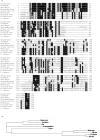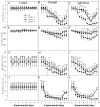A novel stress-induced sugarcane gene confers tolerance to drought, salt and oxidative stress in transgenic tobacco plants
- PMID: 22984543
- PMCID: PMC3439409
- DOI: 10.1371/journal.pone.0044697
A novel stress-induced sugarcane gene confers tolerance to drought, salt and oxidative stress in transgenic tobacco plants
Abstract
Background: Drought is a major abiotic stress that affects crop productivity worldwide. Sugarcane can withstand periods of water scarcity during the final stage of culm maturation, during which sucrose accumulation occurs. Meanwhile, prolonged periods of drought can cause severe plant losses.
Methodology/principal findings: In a previous study, we evaluated the transcriptome of drought-stressed plants to better understand sugarcane responses to drought. Among the up-regulated genes was Scdr1 (sugarcane drought-responsive 1). The aim of the research reported here was to characterize this gene. Scdr1 encodes a putative protein containing 248 amino acids with a large number of proline (19%) and cysteine (13%) residues. Phylogenetic analysis showed that ScDR1is in a clade with homologs from other monocotyledonous plants, separate from those of dicotyledonous plants. The expression of Scdr1 in different varieties of sugarcane plants has not shown a clear association with drought tolerance.
Conclusions/significance: The overexpression of Scdr1 in transgenic tobacco plants increased their tolerance to drought, salinity and oxidative stress, as demonstrated by increased photosynthesis, water content, biomass, germination rate, chlorophyll content and reduced accumulation of ROS. Physiological parameters, such as transpiration rate (E), net photosynthesis (A), stomatal conductance (gs) and internal leaf CO(2) concentration, were less affected by abiotic stresses in transgenic Scdr1 plants compared with wild-type plants. Overall, our results indicated that Scdr1 conferred tolerance to multiple abiotic stresses, highlighting the potential of this gene for biotechnological applications.
Conflict of interest statement
Figures












Similar articles
-
Overexpression of an evolutionarily conserved drought-responsive sugarcane gene enhances salinity and drought resilience.Ann Bot. 2019 Oct 29;124(4):691-700. doi: 10.1093/aob/mcz044. Ann Bot. 2019. PMID: 31125059 Free PMC article.
-
Overexpression of sugarcane gene SoSnRK2.1 confers drought tolerance in transgenic tobacco.Plant Cell Rep. 2016 Sep;35(9):1891-905. doi: 10.1007/s00299-016-2004-0. Epub 2016 Jun 17. Plant Cell Rep. 2016. PMID: 27316630
-
Sugarcane ScDREB2B-1 Confers Drought Stress Tolerance in Transgenic Nicotiana benthamiana by Regulating the ABA Signal, ROS Level and Stress-Related Gene Expression.Int J Mol Sci. 2022 Aug 23;23(17):9557. doi: 10.3390/ijms23179557. Int J Mol Sci. 2022. PMID: 36076957 Free PMC article.
-
Photosynthesis under drought and salt stress: regulation mechanisms from whole plant to cell.Ann Bot. 2009 Feb;103(4):551-60. doi: 10.1093/aob/mcn125. Epub 2008 Jul 28. Ann Bot. 2009. PMID: 18662937 Free PMC article. Review.
-
Sugarcane Water Stress Tolerance Mechanisms and Its Implications on Developing Biotechnology Solutions.Front Plant Sci. 2017 Jun 23;8:1077. doi: 10.3389/fpls.2017.01077. eCollection 2017. Front Plant Sci. 2017. PMID: 28690620 Free PMC article. Review.
Cited by
-
Analysis of differentially expressed genes in abiotic stress response and their role in signal transduction pathways.Protoplasma. 2014 Jan;251(1):81-91. doi: 10.1007/s00709-013-0528-5. Epub 2013 Jul 27. Protoplasma. 2014. PMID: 23893304
-
Overexpression of an evolutionarily conserved drought-responsive sugarcane gene enhances salinity and drought resilience.Ann Bot. 2019 Oct 29;124(4):691-700. doi: 10.1093/aob/mcz044. Ann Bot. 2019. PMID: 31125059 Free PMC article.
-
The choice of reference genes for assessing gene expression in sugarcane under salinity and drought stresses.Sci Rep. 2014 Nov 13;4:7042. doi: 10.1038/srep07042. Sci Rep. 2014. PMID: 25391499 Free PMC article.
-
Heterologous expression of a Glyoxalase I gene from sugarcane confers tolerance to several environmental stresses in bacteria.PeerJ. 2018 Oct 31;6:e5873. doi: 10.7717/peerj.5873. eCollection 2018. PeerJ. 2018. PMID: 30402355 Free PMC article.
-
Oligomerization, membrane association, and in vivo phosphorylation of sugarcane UDP-glucose pyrophosphorylase.J Biol Chem. 2014 Nov 28;289(48):33364-77. doi: 10.1074/jbc.M114.590125. Epub 2014 Oct 15. J Biol Chem. 2014. PMID: 25320091 Free PMC article.
References
-
- Lawlor DW, Cornic G (2002) Photosynthetic carbon assimilation and associated metabolism in relation to water deficits in higher plants. Plant Cell Environ 25: 275–294. - PubMed
-
- Boyer JS (1982) Plant productivity and environment. Science 218: 443–448. - PubMed
-
- Maybank J, Bonsal BR, Jones J, Lawford RG, O’Brien EG, et al. (1995) Drought as a natural disaster. Atmosphere-Ocean 33: 195–222.
-
- Solari LI, Johnson S, DeJong TM (2006) Relationship of water status to vegetative growth and leaf gas exchange of peach (Prunus persica) trees on different rootstocks. Tree Physiol 26: 1333–1341. - PubMed
Publication types
MeSH terms
Substances
LinkOut - more resources
Full Text Sources
Other Literature Sources

